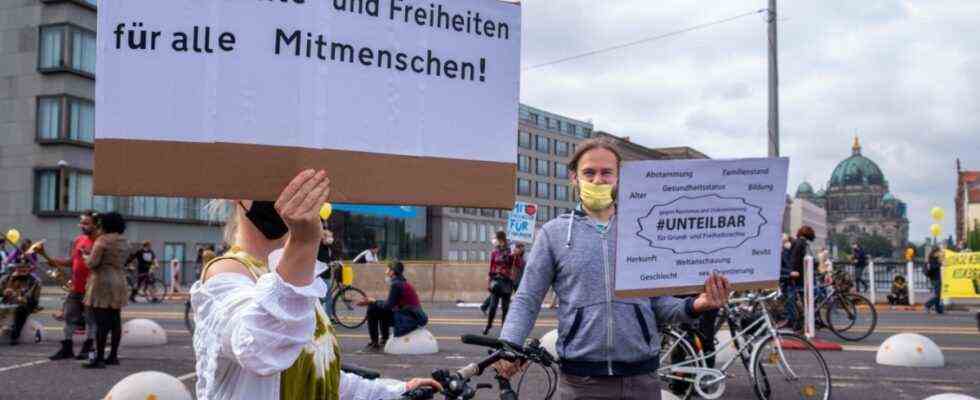Even an alliance that calls itself indivisible has to accept a certain division in the face of the corona pandemic. In order to maintain a safe distance, the organization team divided the large-scale demo on Saturday in Berlin into 16 blocks, which are intended to depict the entire range of left-wing issues: from anti-racism to labor disputes, health care and redistribution to democracy, human rights and climate justice. At the very back, the SPD, the Greens and the Left also gather their supporters – the demonstrators are spread over two kilometers in the government district.
At the beginning the procession seems correspondingly fragmented, the feeling of a large demonstration does not want to arise everywhere. Each block offers its own program of speeches and music, along the route various drum groups in colorful outfits ensure a good atmosphere.
The alliance, made up of more than 340 left-wing initiatives, movements and parties, claims to be able to mobilize around 30,000 people, the police speak of a good 10,000. “In view of the pandemic and the GDL strike, we are absolutely satisfied with the demonstration,” says Helen Deffner, one of the spokespersons for the alliance. The alliance expresses its solidarity with the train drivers on several occasions.
More than 200,000 protesters came to the first indivisible demonstration three years ago, startled at the time by the right-wing extremist protests surrounding a murder in Chemnitz. However, the current demo also has less of the character of an angry “We are more!” than that of a left family meeting shortly before the federal election. “That’s the beauty, the strength of” Indivisible “, that we show solidarity across all topics and organizations, that everyone has a place here,” says Deffner.
In fact, the field of participants is very diverse: young people, families with children, senior citizens, punks. “I was particularly pleased that many migrant people were here and spoke. Many of those affected got a stage today and spoke up,” says Deffner.
At the head of the demo, a large block gathers loudly shouting slogans against racism and for the right to asylum through the center of Berlin. Most of the non-organized participants take part here. Further down, the organizations and parties gather their supporters. You hear less slogans there, the speeches are in the foreground. For example, those of the top candidates for the Berlin House of Representatives election, which will take place on September 26th at the same time as the Bundestag election. Franziska Giffey (SPD), Betina Jarasch (Greens) and Klaus Lederer (Left) use the opportunity to promote themselves and at least partially for a continuation of the alliance of the three parties in the House of Representatives. Several politicians also criticize the CDU and FDP for not participating in Indivisible and thus clearly delimiting to the right. Many people also gather at the trade unions and at “Fridays for Future” as well as in a block that focuses on working conditions in the medical and care sector.
A large number of the participants come by bike and use it as a corona-compliant spacer. Mask requirement and distance rules are almost completely adhered to, says Anja Dierschke from the Berlin police: “That was freedom of expression carried out on the street, as we imagine it – a successful event.”
The police had actually prepared for a difficult day of action. In parallel to Indivisible, the AfD and several alliances of corona deniers had also called for demonstrations and events. “Our focus is therefore on protecting media companies and government buildings,” said Dierschke. Around 1000 emergency services are deployed in total.
Around 3:40 p.m. the head of the indivisible train reached Straussberger Platz in Friedrichshain and was received by the Berlin punk band ZSK. The diversity of left-wing issues is reflected in the following final rally. The most prominent speakers include Carla Reemtsma from Fridays for Future, the Verdi federal chairman Frank Werneke and the whistleblower Edward Snowden. In his function as president of the “Freedom of Press” association, the latter speaks about digital security, the danger of digital espionage and the manipulation of opinion. In addition, two grandchildren remember the recently deceased Holocaust survivor Esther Bejarano, who was quoted many times during the afternoon.
But what made the greatest impression was Said Edris Hashemi and Mirkan Unvar, survivors of the attack in Hanau and brothers of victims of the right-wing attacker. “Imagine meeting your boys like you do every evening. But your brother doesn’t come back because someone couldn’t stand the fact that some people have brown eyes,” says Unvar. And Hashemi reports that they had to become investigators themselves to find out all the background information. Unvar’s final appeal not to be divided by the right or to let the police and bureaucracy downplay it receives the longest and loudest applause of the afternoon. Many of those still present rise from the picnic blankets they have brought with them. A unifying experience under the late summer sun that was still emerging – in the style of a family get-together.

